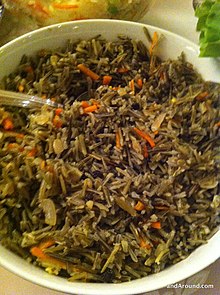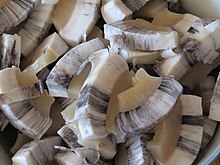lunes, 27 de abril de 2020
"Nipponic" Identity
Many people have confusion about my identity. I could say that I am a multilingual "Nipponic" living in the Anglosphere. I deny neither my "Filipinoness" nor my "Hispanicity."
sábado, 25 de abril de 2020
Western Native American cuisine
In the Pacific Northwest, traditional diets include salmon and other fish, seafood, mushrooms, berries, and meats such as deer, duck, and rabbit. In contrast to the Easterners, the Northwestern peoples are traditionally hunter-gatherers, primarily. The generally mild climate led to the development of an economy based on year-round abundant food supplies, rather than having to rely upon seasonal agriculture. In what is now California, acorns can be ground into a flour that has at times served as the principal foodstuff for about 75 percent of the population,[24] and dried meats can be prepared during the dry season.[25]
https://en.m.wikipedia.org/wiki/Indigenous_cuisine_of_the_Americas
https://en.m.wikipedia.org/wiki/Indigenous_cuisine_of_the_Americas
Tiswin
Tiswin is an alcoholic beverage brewed from corn. Tiswin is also the sacred saguaro wine of the Tohono O'odham, a group of aboriginal Americans who reside primarily in the Sonoran Desert of the southeastern Arizona and northwest Mexico.
The saguaro, the largest cactus in the world, is in many respects the sacred tree of the Tohono O'odham, who reside in the Sonoran Desert of southeastern Arizona and northwest Mexico. From the fruit of the saguaro they make a sacred fermentation called tiswin or sometimes nawai.
https://en.m.wikipedia.org/wiki/Tiswin
https://en.m.wikipedia.org/wiki/Tiswin
Guarani Phonology
Guarani syllables consist of a consonant plus a vowel or a vowel alone; syllables ending in a consonant or two or more consonants together do not occur. This is represented as (C)V(V).
- Vowels: /a/, /e/, /i/, /o/, /u/ correspond more or less to the Spanish and IPA equivalents, although sometimes the allophones [ɛ], [ɔ] are used more frequently; the grapheme ⟨y⟩ represents the vowel /ɨ/ (as in Latgalian).
| Front | Central | Back | |
|---|---|---|---|
| Close | /i/, /ĩ/ | /ɨ/, /ɨ̃/ | /u/, /ũ/ |
| Mid | /e/, /ẽ/ | /o/, /õ/ | |
| Open | /a/, /ã/ |
IPA value is shown. The orthography is shown in angle brackets below, if different.
| Labial | Alveolar | Alveolo-palatal | Velar | Lab. velar | Glottal | ||
|---|---|---|---|---|---|---|---|
| Stop | Voiceless | p | t | k | kʷ ⟨ku⟩ | ʔ ⟨'⟩ | |
| Voiced | ᵐb~m ⟨mb~m⟩ | ⁿd~n ⟨nd~n⟩ | ᵈj~ɲ ⟨j~ñ⟩ | ᵑɡ~ŋ ⟨ng⟩ | ᵑɡʷ~ŋʷ ⟨ngu⟩ | ||
| Fricative | s | ɕ ⟨ch⟩ | x~h ⟨h⟩ | ||||
| Approximant | ʋ ⟨v⟩ | ɰ ~ ɰ̃ ⟨g⟩ ~ ⟨g̃⟩ | w ~ w̃ ⟨gu⟩ ~ ⟨g̃u⟩ | ||||
| Flap | ɾ ⟨r⟩ | ||||||
The voiced consonants have oral allophones (left) before oral vowels, and nasal allophones (right) before nasal vowels. The oral allophones of the voiced stops are prenasalized.
There is also a sequence /ⁿt/ (written ⟨nt⟩). A trill /r/ (written ⟨rr⟩), and the consonants /l/, /f/, and /j/ (written ⟨ll⟩) are not native to Guarani, but come from Spanish.
Oral [ᵈj] is often pronounced [dʒ], [ɟ], [ʒ], [j], depending on the dialect, but the nasal allophone is always [ɲ].
The dorsal fricative is in free variation between [x] and [h].
⟨g⟩, ⟨gu⟩ are approximants, not fricatives, but are sometimes transcribed [ɣ], [ɣʷ], as is conventional for Spanish. ⟨gu⟩ is also transcribed [ɰʷ], which is essentially identical to [w].
All syllables are open, viz. CV or V, ending in a vowel.
Glottal stop
The glottal stop is only written between vowels, but occurs phonetically before vowel-initial words. Because of this, Ayala (2000:19) shows that some words have several glottal stops near each other, which consequently undergo a number of different dissimilationtechniques. For example, "I drink water" 'a'u'y is pronounced hau'y. This suggests that irregularity in verb forms derives from regular sound change processes in the history of Guarani. There also seems to be some degree of variation between how much the glottal stop is dropped (for example aru'uka > aruuka > aruka for "I bring"). It is possible that word-internal glottal stops may have been retained from fossilized compounds where the second component was a vowel-initial (and therefore glottal stop–initial) root.[20]:19
Nasal harmony
Guarani displays an unusual degree of nasal harmony. A nasal syllable consists of a nasal vowel, and if the consonant is voiced, it takes its nasal allophone. If a stressed syllable is nasal, the nasality spreads in both directions until it bumps up against a stressed syllable that is oral. This includes affixes, postpositions, and compounding. Voiceless consonants do not have nasal allophones, but they do not interrupt the spread of nasality.
For example,
- /ⁿdo+ɾoi+ⁿduˈpã+i/ → [nõɾ̃õĩnũˈpãĩ]
- /ro+ᵐbo+poˈrã/ → [ɾ̃õmõpõˈɾ̃ã]
However, a second stressed syllable, with an oral vowel, will not become nasalized:
- /iᵈjaˈkãɾaˈku/ → [ʔĩɲãˈkãɾ̃ãˈku]
- /aˈkãɾaˈwe/ → [ʔãˈkãɾ̃ãˈwe][21]
That is, for a word with a single stressed vowel, all voiced segments will be either oral or nasal, while voiceless consonants are unaffected, as in oral /ᵐbotɨ/ vs nasal /mõtɨ̃/.
https://en.m.wikipedia.org/wiki/Guarani_language
https://en.m.wikipedia.org/wiki/Guarani_language
Muktuk
Muktuk is most often made from the skin and blubber of the bowhead whale, although the beluga and the narwhal are also used. Usually eaten raw, today it is occasionally finely diced, breaded, deep fried, and then served with soy sauce. Despite it being usually eaten raw it could also be eaten frozen or cooked.[2] It is also sometimes pickled.[3] When chewed raw, the blubber becomes oily, with a nutty taste; if not diced, or at least serrated, the skin is quite rubbery.
Italio kaj Francio inter Japanoj
Multaj japanoj opinias, ke inter eŭropaj landoj, eble Italio kaj Francio plej allogas japanojn.
Novzelando kaj Tiel Plu
Kelkaj japanoj opinias, ke kelkaj lokoj kiel Novzelando en la futuro ne parolos la anglan, sed alian lingvon.
Acorn Mush
Wiiwish, also known as acorn mush, was one of the main food staples of California Indians. Acorns were gathered in the fall before the rain came. To harvest the acorns, California Indians would crack open the shell and pull out the inner part of the acorn. This part of the acorn was then smashed with a mortar and pestle until it was a flour-like consistency. This flour-like substance was then leached several times with water until the acorn mush was no longer bitter (this also indicated that the mush was safe for consumption). This mush was then cooked in a waterproof basket with hot rocks and then served. California Indians continue to eat wiiwish both the traditional way and with alterations. These alterations include using other tools to grind down the acorns such as a coffee grinder or/and adding sugar or other seasonings to the finished wiiwish.
viernes, 24 de abril de 2020
Native Wild Rice

Wild rice is a native traditional food of Minnesota, Wisconsin, Michigan, and some areas of North Dakota.[1]
https://en.m.wikipedia.org/wiki/Indigenous_cuisine_of_the_Americas
Yucatec Maya Phonology
A characteristic feature of Yucatec Maya, like other Mayan languages, is the use of ejective consonants: /pʼ/, /tʼ/, /kʼ/. Often referred to as glottalized consonants, they are produced at the same place of oral articulation as their non-ejective stop counterparts: /p/, /t/, /k/. However, the release of the lingual closure is preceded by a raising of the closed glottis to increase the air pressure in the space between the glottis and the point of closure, resulting in a release with a characteristic popping sound. The sounds are written using an apostrophe after the letter to distinguish them from the plain consonants (tʼàan "speech" vs. táan "forehead"). The apostrophes indicating the sounds were not common in written Maya until the 20th century but are now becoming more common. The Mayan b is also glottalized, an implosive /ɓ/, and is sometimes written bʼ, but that is becoming less common.
Yucatec Maya is one of only three Mayan languages to have developed tone, the others being Uspantek and one dialect of Tzotzil. Yucatec distinguishes short vowels and long vowels, indicated by single versus double letters (ii ee aa oo uu), and between high- and low-tone long vowels. High-tone vowels begin on a high pitch and fall in phrase-final position but rise elsewhere, sometimes without much vowel length. It is indicated in writing by an acute accent (íi ée áa óo úu). Low-tone vowels begin on a low pitch and are sustained in length; they are sometimes indicated in writing by a grave accent (ìi èe àa òo ùu).
Also, Yucatec has contrastive laryngealization (creaky voice) on long vowels, sometimes realized by means of a full intervocalic glottal stop and written as a long vowel with an apostrophe in the middle, as in the plural suffix -oʼob.
Consonants
| Labial | Alveolar | Palatal | Velar | Glottal | ||
|---|---|---|---|---|---|---|
| Nasal | m [m] | n [n] | ||||
| Implosive | b [ɓ] | |||||
| Plosive | plain | p [p] | t [t] | k [k] | ʼ [ʔ] | |
| ejective | pʼ [pʼ] | tʼ [tʼ] | kʼ [kʼ] | |||
| Affricate | plain | tz [ts] | ch [tʃ] | |||
| ejective | tzʼ [tsʼ] | chʼ [tʃʼ] | ||||
| Fricative | s [s] | x [ʃ] | j [x] | h [h] | ||
| Approximant | w [w~v]† | l [l] | y [j] | |||
| Flap | r [ɾ] | |||||
† the letter w may represent the sounds [w] or [v]. The sounds are interchangeable in Yucatec Mayan although /w/ is considered the proper sound.
Some sources describe the plain consonants as aspirated, but Victoria Bricker states "[s]tops that are not glottalized are articulated with lung air without aspiration as in English spill, skill, still."[10]
Vowels
In terms of vowel quality, Yucatec Maya has a straight-forward five vowel system:
| Front | Back | |
|---|---|---|
| Close | i | u |
| Mid | e | o |
| Open | a | |
For each of these five vowel qualities, the language contrasts four distinct vowel "shapes", i.e. combinations of vowel length, tone, and phonation. In the standard orthography first adopted in 1984,[11] vowel length is indicated by digraphs (e.g. "aa" for IPA [aː]).
| Short, neutral tone | Long, low tone | Long, high tone | Creaky voiced ('glottalized, rearticulated'), long, high tone |
|---|---|---|---|
| pik 'eight thousand' [pik] | miis 'cat' [mìːs] | míis [míːs] 'broom; to sweep' | niʼichʼ [nḭ́ːtʃʼ] 'to get bitten' |
In fast-paced speech, the glottalized long vowels may be pronounced the same as the plain long high vowels, so in such contexts ka’an [ká̰ːn] 'sky' sounds the same as káan [káːn]'when?'.
Stress
Mayan words are typically stressed on the earliest syllable with a long vowel. If there is no long vowel, then the last syllable is stressed. Borrowings from other languages such as Spanish or Nahuatl are often stressed as in the original languages.
https://en.m.wikipedia.org/wiki/Yucatec_Maya_language
https://en.m.wikipedia.org/wiki/Yucatec_Maya_language
Suscribirse a:
Entradas (Atom)
-
Tiswin is an alcoholic beverage brewed from corn . Tiswin is also the sacred saguaro wine of the Tohono O'odham , a group of ab...










